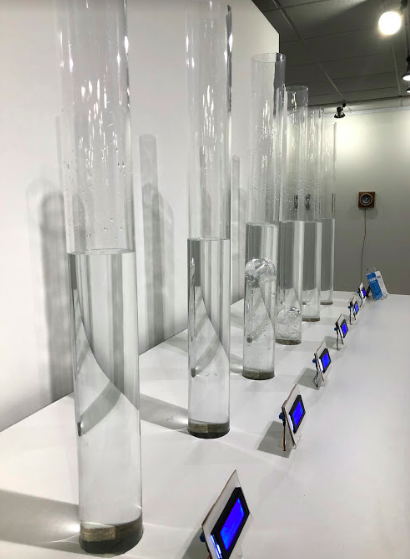The Edith Langley Barrett Fine Arts Gallery is hosting a new fall exhibit. Titled Impact!, the exhibition showcases works by artist Jon Bellona and opened Thursday, Sept. 19.
Dozens of attendees, including members of the UC community and local visitors gathered at the art gallery to check out Bellona’s work throughout its first week of display.
Those stopping by the art gallery will notice that Bellona’s exhibit does not present any framed artwork or photographs. Instead, hanging radios, transparent cylinders and synchronized speakers star in the exhibit.
Using data and sounds, the exhibit tries to spark critical thinking about pressing contemporary issues but also “to raise awareness about the impacts and choices that we make, which have a cost on the world,” Bellona said.
“We’re all going to make choices, […] and everything has a cost and by understanding what those costs are, we can make more informed decisions, even if they do have an impact because they will.”
Bellona has shown his artwork all around the country, including his alma mater Hamilton College, and said it is “great to see how a show like this can help bring different colleges and communities together,” as if there was a dialogue between them.
Bringing Impact! to UC had many challenges, according to Bellona. From shipping the 21 boxes that contained the artwork to installing the pieces, which use wires and electricity as its source of power.
In fact, the piece “Wildfire” is the first time it’s ever been set up, according to Bellona.
“Doing a new work that has a lot of electronics in a new space takes a while but it feels great once it’s done,” he said.
Sophomore Natalie Devine visited the art gallery and said she came to the conclusion that Bellona’s exhibit was “unlike anything else” she had seen before.
In addition, since the artwork is so abstract and different from what the art gallery is used to presenting, Devine said she had a “hard time connecting with the art and seeing some of its relations […] and purpose.”
Other students such as Derek Franco said he also struggled when it comes to relating to the meaning of the art.
However, not only is the exhibit different because of the artwork, but it comes after the resignation of Megan Austin, former Barrett Art Gallery director, last summer.
“My departure was a little more abrupt than I thought it was going to be,” Austin said. “I’m surprised at how it all kind of went down.” I would remove this bc it suggest some sort of falling out or ill will and we don’t have someone from the college to respond.
Before leaving, Austin planned and curated the fall exhibition even though she could not attend the opening last Thursday, which she said was “definitely bittersweet” for her.
“I really believe in Jon Bellona’s work because there are a lot of access points that have to do with environmental and political issues and he showcases them in such a new and interesting way,” Austin said.
“I wanted something that facilitates growth and thought and gets to a place that challenges you or perhaps reinforces how you feel about something,” because, for Austin, that is the power of art.
After Austin’s resignation, Collections Manager Sarisha Hoogheem took over some of the director’s roles to finalize putting together the new fall exhibit.
Hoogheem said she hopes to find a new art gallery director soon and to continue to bring in classes from UC and even from other colleges “so that people can utilize what’s on display and the permanent collection as well.”
Having an art gallery on campus “is a big asset for UC,” Hoogheem said.
For the collections manager, the importance of the gallery does not only have to do with marketing and appealing to local visitors, but especially because “art is just another way of incorporating learning into the core curriculum,” she expressed.
“It really helps with critical thinking skills, and that goes beyond the visual arts but it can also be applied in life in general,” Hoogheem said. “Art holds our history. It’s part of who we are and I think having that and being able to share that with people is really important.”
After Austin’s departure, Denman expressed his desire of finding a permanent director although that would be “really rushed.”
“We want to know that [the applicants] are super qualified and we want to know their vision for the art gallery and to assess how their vision aligns with what faculty, staff and students want,” Denman said.
To avoid rushing the process of hiring a new art gallery director, Denman said the plan is to acquire an interim director, “presumably for one semester, perhaps three, while the institution does a bigger search for a permanent director.”
While UC is in active search for a new director, Denman said there are no other exhibits arranged to go up in the gallery in the Spring.
In the meantime, Denman took the role of trying to collect as many ideas from faculty members about the direction that the art gallery should move towards.
“I expect to hear very different and conflicting ideas and it will be hard to figure out what will be the right thing to do,” Denman said. “Some people will want ambitious, highly professional exhibits like we have now and [others] will want to see the local photography club or student work.”
However, Denman said he is interested in hearing student opinions as well due to the constant relationship that the art gallery director position has with students, whether it has to do with student work and internship opportunities at the gallery, or using the space and exhibits as academic resources.
And students are already bringing their ideas in. According to Franco, the art gallery should make a shift and start showcasing student art or artists “whose themes and styles college kids relate to.”
For Devine, the significance of having an art gallery on campus is “to get all the students to think outside the box and to have art easily accessible.”
“[The gallery] gets students to be more creative and can even inspire them by giving each of us to interpret the work in our own way,” Devine said.
As for her ideas, the sophomore said it would be “awesome if we had student art” exhibited in the art gallery.
“It would be more engaging for us to see our peers’ work that can inspire us more than a famous artist would,” Devine said.





































































































































